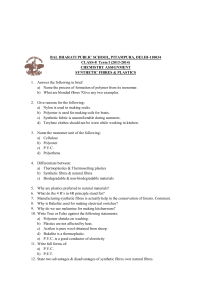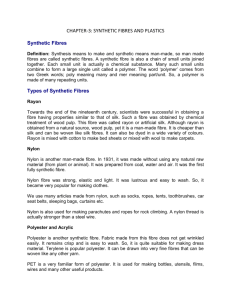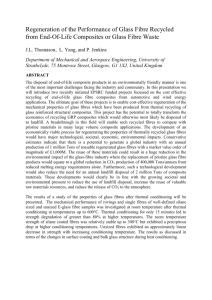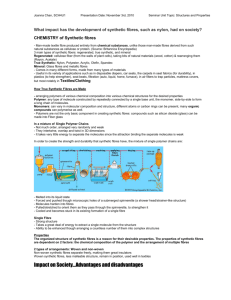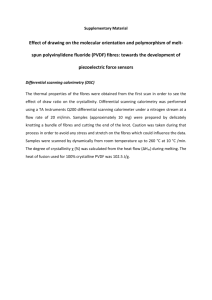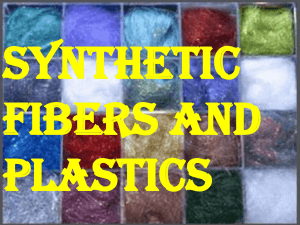3.2 Synthetic Fibres - e-CTLT
advertisement
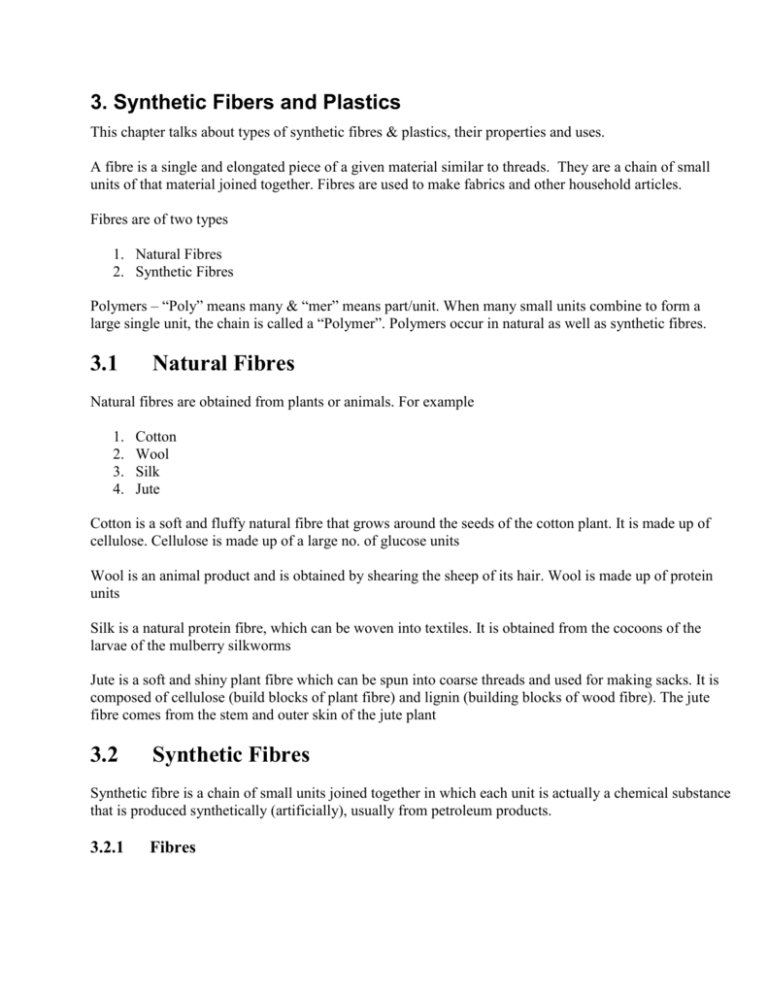
3. Synthetic Fibers and Plastics This chapter talks about types of synthetic fibres & plastics, their properties and uses. A fibre is a single and elongated piece of a given material similar to threads. They are a chain of small units of that material joined together. Fibres are used to make fabrics and other household articles. Fibres are of two types 1. Natural Fibres 2. Synthetic Fibres Polymers – “Poly” means many & “mer” means part/unit. When many small units combine to form a large single unit, the chain is called a “Polymer”. Polymers occur in natural as well as synthetic fibres. 3.1 Natural Fibres Natural fibres are obtained from plants or animals. For example 1. 2. 3. 4. Cotton Wool Silk Jute Cotton is a soft and fluffy natural fibre that grows around the seeds of the cotton plant. It is made up of cellulose. Cellulose is made up of a large no. of glucose units Wool is an animal product and is obtained by shearing the sheep of its hair. Wool is made up of protein units Silk is a natural protein fibre, which can be woven into textiles. It is obtained from the cocoons of the larvae of the mulberry silkworms Jute is a soft and shiny plant fibre which can be spun into coarse threads and used for making sacks. It is composed of cellulose (build blocks of plant fibre) and lignin (building blocks of wood fibre). The jute fibre comes from the stem and outer skin of the jute plant 3.2 Synthetic Fibres Synthetic fibre is a chain of small units joined together in which each unit is actually a chemical substance that is produced synthetically (artificially), usually from petroleum products. 3.2.1 Fibres The following are the different types of Synthetic Fibres 1. Rayon – It is also called as Artificial Silk. It is obtained from wood pulp, but it is still considered to be a synthetic fibre. It is cheaper than silk and can be woven like silk fibres. It can also be dyed in a wide variety of colours. 2. Nylon – It was the first fully synthetic fibre prepared from coal, water & air in 1931. Nylon is strong, elastic & light. Actually, nylon fibre is even stronger than a steel wire. Because of these properties nylon is used to make parachutes & ropes for rock climbing as it can sustain the weight of a human body also. 3. Polyester – As the names suggests it is composed of repeating (poly) units of esters. Ester is a type of chemical, which consists of an Acid + Alcohol molecule combination. Interestingly, esters are the chemicals which give fruits their smell. It is wrinkle-free, remains crisp & is easy to wash. Terylene is a type of polyester, which is popular for making dress materials. PET is also a type of polyester and is used for making products like water bottles, films etc. 4. Acrylic – This synthetic fibre resembles wool. Acrylic is less expensive than wool, is durable & is available in wide variety of colours. The following are the characteristics/ advantages of Synthetic Fibres 1. 2. 3. 4. 5. Durable Less expensive Absorb less water Readily available Easy to maintain The main disadvantage of synthetic fibres is that if they get burnt, they melt & stick to the body of the person wearing it. So, we should never wear clothes made of synthetic fabrics while working in the kitchen or in a laboratory. There are some fabrics which are made by mixing two types of fibres. For example 1. Polycot (Polyester + Cotton) 2. Polywool (Polyester + Wool) 3. Terrycot (Terylene + Cotton) Such fabrics exhibit the properties of both the fibres and are generally cheaper and better than the fabrics of individual fibres 3.2.2 Plastics Plastics are also polymers just like synthetic fibres. Some plastics have a linear arrangement of constituent units while others have a cross-linked structure The following are the characteristics/advantages of Plastics 1. 2. 3. 4. 5. Light, strong & durable Non-reactive – It does not corrode as it does not react with water & air Easily mouldable into various shapes/objects Can be recycled and reused Cheaper than metals therefore plastic goods are cost effective as compared to equivalent metallic goods. For example – buckets, bins etc 6. Poor conductors of heat & electricity so they are used as covering for electrical wires and as handles for screw drivers. Plastics can be classified into following categories based on their thermal properties 1. Thermoplastics 2. Thermosetting Plastics The following is the difference between thermoplastics & thermosetting plastics Thermal characteristics Uses Thermoplastics They are not heat resistant and get deformed easily on heating Used in the manufacturing of toys, combs, containers etc Thermosetting Plastics Once moulded, they cannot be softened on heating Used in the manufacturing of electrical switches, handles of utensils etc Examples 1. Polythene 3. Bakelite 2. PVC 4. Melamine 5. Teflon Some interesting uses of Plastics 1. Teflon is used for coating the inside of non stick cookware. It has high melting point and can be used safely. The food does not stick to this material; therefore we need to add less oil for food preparation 2. Microwave cooking requires special plastics, which do not melt during cooking 3. Uniforms of fireman are coated with melamine, thus making it flame resistant 3.3 Plastics & the Environment The materials that are decomposed through natural processes such as action by bacteria are called Biodegradable Materials. Vegetable waste, paper, cotton clothes, wood & woollen clothes are biodegradable. The materials which are not easily decomposed by natural processes are called non-Biodegradable materials. For example – Tin, aluminium, metal coins & plastic bags are non-biodegradable The following are the disadvantages of using non-biodegradable materials such as plastics 1. They are not environment friendly. Once they are created, they cannot be destroyed naturally and the disposal of garbage containing such material becomes difficult 2. Animals eating garbage from the garbage dump swallow polythene bags & food wrappers. The plasters choke their respiration system & this may lead to their death 3. Polythene bags thrown here & there, clog the sewers and drains creating sanitation problems
